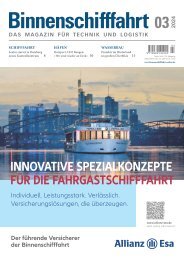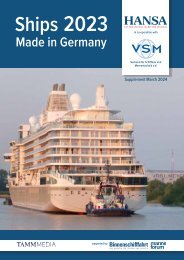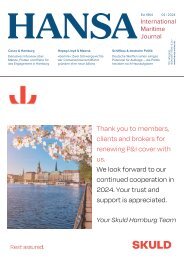HANSA 03-2018
Propeller Performance | Koalitionsvertrag | Jubiläum ZVDS | Robotik im Hafen | Ballastwasser Survey 2018 | Finanz- und Schifffahrtsstandort Nordamerika | Zeaborn & Rickmers
Propeller Performance | Koalitionsvertrag | Jubiläum ZVDS | Robotik im Hafen | Ballastwasser Survey 2018 | Finanz- und Schifffahrtsstandort Nordamerika | Zeaborn & Rickmers
Sie wollen auch ein ePaper? Erhöhen Sie die Reichweite Ihrer Titel.
YUMPU macht aus Druck-PDFs automatisch weboptimierte ePaper, die Google liebt.
Häfen | Ports<br />
Vancouver has grown rapdily in the last five years<br />
Photo: Port of Vancouver<br />
Growth prospects under the maple leaf<br />
Many Canadian ports prepare for growth. The »new« policy further south beyond the U.S.<br />
border causes worries and a glimmer of hope at the same time. Canadian Ports are not<br />
merely eying their southern neighbours but are fully aware of the prospects beyond the<br />
oceans to the East and West. By Michael Meyer<br />
Speaking to <strong>HANSA</strong>, Wendy Zatylny,<br />
President of the Association of Canadian<br />
Port Authorities (ACPA), explains:<br />
»Although it is difficult to say with certainty<br />
what prospects are, given growing<br />
nationalism and protectionism, currently<br />
prospects for Europe and Asia are<br />
positive and balance the uncertainty in<br />
trade with the U.S.« Trade with Asia, due<br />
to demand for agricultural products and<br />
natural resources, combined with trade<br />
agreements such as the Comprehensive<br />
and Economic Trade Agreement with the<br />
EU, the Canada-South Korea Free Trade<br />
Agreement and the recently signed Trans<br />
Pacific Partnership (TPP), should provide<br />
the basis for growth in trade, Zatylny<br />
thinks. »We do expect CETA to increase<br />
transatlantic trade between Canada and<br />
the EU.« Canadian ports are developing<br />
facilities to meet anticipated demand.<br />
Trade with the U.S. has always been very<br />
strong – in fact the strongest trading relationship<br />
in the world – thanks in large<br />
part to the 30-year-old North American<br />
Free Trade Agreement (NAFTA). However,<br />
»this trade relationship is uncertain<br />
due to the current renegotiation of NAF-<br />
TA and the protectionist polices of the<br />
current U.S. regime.«<br />
U.S. trade policy and domestic environmental<br />
regulations are making Canadian<br />
ports a very attractive option for<br />
trade with North America, she explains.<br />
In fact, Canadian ports may benefit from<br />
the uncertain climate in the US and the<br />
lowering of environmental and labour<br />
rules and regulations which could fall<br />
below required global standards for marine<br />
and environmental regulations. In<br />
addition, in the eye of the association, the<br />
proximity of western ports to Asia combined<br />
with rail and truck linkages will<br />
also make these hubs competitive compared<br />
to US ports.<br />
However, a potential challenge to Canada<br />
is that of a »thickening« of the border<br />
with the U.S., hence slowing down trade<br />
fluidity. Zatylny hopes that earlier joint<br />
Canada/U.S. »Beyond the Border« initiatives<br />
have been institutionalized and will<br />
prevent border friction. Commenting on<br />
global seaway developments, ACPA says,<br />
the expanded Panama Canal is having a<br />
positive impact on east coast port business.<br />
Specifically, Halifax may enjoy increased<br />
north-south trade through Panama. The<br />
other factor to consider is the widening of<br />
the Suez Canal which may also lead to increased<br />
traffic to Halifax/Montreal.<br />
Nevertheless, Zatylny sees a number<br />
of challenges that ports face: »They have<br />
significant deferred maintenance needs<br />
as well as demand for capital to innovate<br />
and expand and current funding<br />
from the Federal Government is oversubscribed<br />
and not targeted to ports specifically.«<br />
The country’s most dominant port,<br />
Vancouver, responds to future tasks involving<br />
the following projects:<br />
The Roberts Bank Terminal 2 (RBT2):<br />
This is a proposed new three-ship container<br />
terminal. The project would provide<br />
2.4 mill. TEU of capacity and is<br />
needed to meet forecasted demand.<br />
The proposed Centerm Expansion Project<br />
is part of the port authority’s longterm<br />
strategy. The proposed expansion<br />
looks to increase the capacity by approximately<br />
two-thirds. The Deltaport Termi-<br />
82 <strong>HANSA</strong> International Maritime Journal – 155. Jahrgang – <strong>2018</strong> – Nr. 3


















